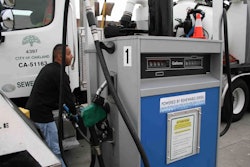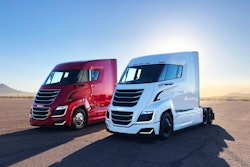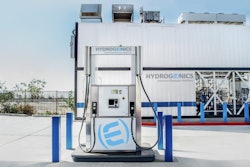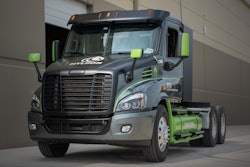This is the first part in a multi-part series exploring the costs and viability of fuel cell technology as an alternative to diesel-powered Class 8 trucks. See the rest of series at this link.
When it comes to betting on future powertrain technology, the leader of one iconic diesel manufacturer is stacking his chips on hydrogen fuel cells.
While he may not be repeating Nikola founder Trevor Milton’s social media mantra #DIESELISDEAD, Cummins CEO and Chairman Tom Linebarger lauded Nikola for building interest in fuel cell technology and made it clear that his company also believes that fuel cells are one of the powertrains of the future.
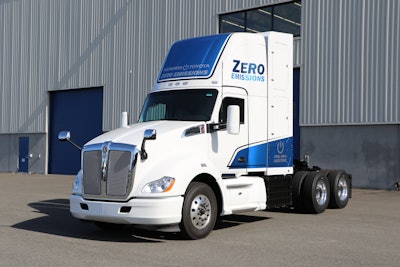 Kenworth recently announced that ten of its T680 fuel cell trucks would be heading to the Port of Los Angeles.
Kenworth recently announced that ten of its T680 fuel cell trucks would be heading to the Port of Los Angeles.“We offer…everything from diesel and natural gas to electrification and now hydrogen fuel cells and hydrogen from electrolyzers,” Linebarger said during a recent webinar hosted by the International Partnership for Hydrogen and Fuel Cells in the Economy (IPHE), “but I’m very confident that hydrogen will be a bigger and bigger part of that portfolio over time and at some point in the future it will be the single largest part of what Cummins provides to customers.”
The momentum from both stalwart players like Cummins and upstarts like Nikola to deploy zero-emission Class 8 trucks comes as regulators begin the march toward mandating that a certain percentage of trucks sold each year produce no emissions. The California Air Resources Board made history in June by announcing that OEMs will be required to begin selling zero-emission commercial trucks and vans in 2024.
As has been the case with California’s legislative actions in the past, other states are catching on fast. In mid-July, CCJ reported that a total of 15 states had signed on for the Multi-State Medium- and Heavy-Duty Zero Emission Vehicle Memorandum of Understanding which is calling for 30% of new commercial truck and bus sales to be zero-emission by 2030 and 100% zero-emission by 2050.
Those are tight deadlines for OEMs to find technology that works, even if deployed on a small scale in just a few states.
Like other major manufacturers, Linebarger said, Cummins “has pledged to be net zero carbon emissions by 2050.” While advancements in diesel emissions reductions continue, including Cummins’ business partner Achates’ two-stroke near-zero diesel truck engine, at this point Cummins is reaching for fuel cells to hit tough zero-emissions targets.
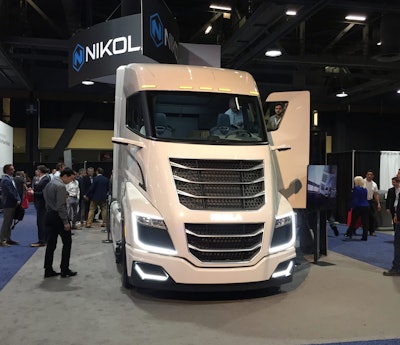 The Nikola Two on display at the 2019 Advanced Clean Transportation Expo in Long Beach, Calif.
The Nikola Two on display at the 2019 Advanced Clean Transportation Expo in Long Beach, Calif.The company has more than 2,000 fuel cells in operation, which includes trucks in Europe and buses in China. This month the OEM was awarded nearly $7 million from the U.S. Department of Energy (DOE) to enable more fuel cell development and accelerate the ongoing effort to drive down cost parity in a challenging field dominated by diesel.
To bolster its commitment, Cummins acquired fuel cell and hydrogen production company Hydrogenics in 2019 and last month acquired hydrogen storage manufacturer NPROXX.
The two-prong strategy of producing fuel cells and procuring methods of hydrogen production and storage are also in step with Nikola Motor Company’s own tact, which in June announced a contract with Norway-based Nell to acquire 85-megawatt alkaline electrolyzers to support five of the world’s first 8-ton per day hydrogen stations. Milton told CCJ that mass production of H2 at his headquarters in Arizona has already undercut the price of diesel.
“That’s why we have a hashtag, diesel is dead. It truly is dead,” Milton said. “Because now it’s cheaper to operate with hydrogen than diesel. This is the first time in history that we’ve been able to do that.”
Though Cummins has 101-year history in commercial transportation, the new kid on the block, Nikola, is the one making waves and attracting billions of dollars from eager investors, which is a bit of a mystery to Linebarger, though he considers it good news for the industry.
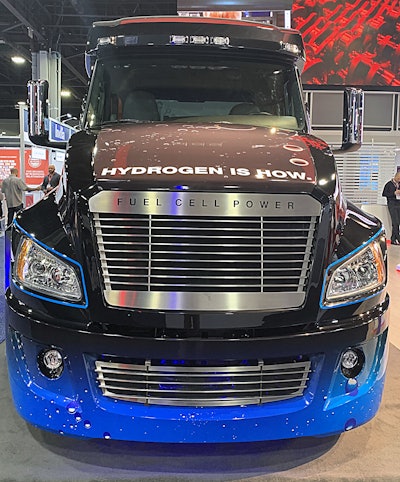 On display in November at the North American Commercial Vehicle Show was Cummins’ Class 8, 6×4 day cab fuel cell tractor.
On display in November at the North American Commercial Vehicle Show was Cummins’ Class 8, 6×4 day cab fuel cell tractor.“While none of us understands how the valuation could be that high without selling a truck, it’s really good for the industry,” Linebarger said. “It increases awareness about the possibility which is what we need.”
Not all fuel cell proponents believe the technology is the best Class 8 solution. Hybrid powertrain start-up Hyliion recently announced its Hypertruck Electric Range Extender (ERX) with a generator fueled by renewable natural gas, which has the lowest carbon index score by far over all other fuels, including hydrogen. The Texas-based company, which remains fuel agnostic, is also developing a fuel cell generator for a fleet that requested it.
“Hydrogen fuel cell is an exciting technology that has the potential to be a sustainable fuel for the commercial transportation industry, but there are still many hurdles to overcome to prove its viability,” said Thomas Healy, founder and CEO of Hyliion.
Such hurdles include, at this point, lack of a fueling network and, proponents say, lack of government funding for research and development.
The DOE remains encouraged by several fuel cell projects that it’s been funding over the years. Progress continues in hydrogen production, storage and fuel cell lifespan. In the past 12 months, DOE has pledged an additional $268 million for hydrogen infrastructure and fuel cell development, which includes the construction of a Class 8 work-ready, long-haul truck.
Still, fuel cell proponents around the globe acknowledge plenty of challenges ahead including what Linebarger and others believe is the need for additional public investment at home.
“The public investment in the U.S. is not good enough,” Linebarger said during the IPHE webinar. While the DOE “has done a of important work to promote hydrogen and is still working hard” he would like to see “larger public investment in the U.S.”
But not everyone thinks it would be money well spent. Long-time fuel cell critic and Tesla CEO Elon Musk has maintained that all-electric powertrains are superior to fuel cells, or “fool cells,” as he’s called them. He criticizes hydrogen for being less energy efficient than all-electric, for causing metal embrittlement and for being extremely flammable. No stranger to flammability, Tesla is currently under federal investigation following several battery fires in its electric cars. The Tesla Semi, which has incurred multiple production delays, remains under development. It is a rechargeable, battery-powered rig.
Critics like Musk aren’t slowing Milton and others down.
“We kind of got mocked by a lot of people and proved a lot of naysayers wrong and the rest of the world is jumping in,” Milton said. “Look at Europe. It’s completely going hydrogen everywhere in Europe and America is a little bit different for cars and that’s OK. But trucking, I believe, is going to be almost entirely hydrogen because of the weight and the costs. It just makes more sense to go hydrogen.”
Linebarger agrees and believes that in addition to more public funding, more public awareness is needed for fuel cells to compete in a growing zero-emission segment where social media kings like Musk tend to dominate the news with all-electric powertrains.
“My own children know a lot about batteries,” Linebarger said. “They’re very excited about Tesla. When I ask them about fuel cells they don’t even know what I’m talking about. I need them to know, not because they’re the investors, but because this imagination increases people’s public interest, it increases government interest and it increases investor interest.”
Next in this series: Hydrogen-powered Class 8 rigs: How fuel cell trucks produce electric power and how they’re fueled

